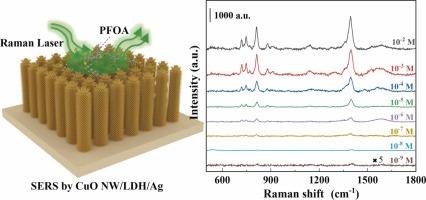3D CuO/NiCo/Ag hierarchical SERS nanostructures for direct detection of trace perfluorooctanoic acid
IF 3.7
1区 化学
Q1 CHEMISTRY, ANALYTICAL
引用次数: 0
Abstract
Perfluorooctanoic acid (PFOA), a ubiquitous emerging contaminant in global aquatic environments, poses significant challenges for Raman spectroscopic detection due to its inherent molecular properties, including high toxicity and extreme persistence. To address this limitation, we engineered a three-dimensional hierarchical nanostructure based on CuO nanowire (NW)/layered double hydroxide (LDH)/silver (Ag) as a surface-enhanced Raman scattering (SERS) substrate. Within this architecture, electrostatic interactions between the LDH component and PFOA molecules significantly enhance the efficient adsorption of the target analyte. Concurrently, the uniform distribution of Ag nanoparticles ( NPs) across the substrate surface generates intense localized plasmonic hotspots under light-trapping effect, which is crucial for Raman signal amplification. Consequently, this substrate enables the direct detection of trace PFOA across a wide dynamic range (10⁻² to 10⁻⁹ M). This capability facilitates the effective and direct identification of PFOA molecules without requiring complex pretreatment or indirect labeling procedures. These results demonstrate the substantial potential of the CuO NW/LDH/Ag structure for highly sensitive, direct SERS-based monitoring of organic pollutants such as PFOA.

三维CuO/NiCo/Ag分层SERS纳米结构直接检测痕量全氟辛酸
全氟辛酸(PFOA)是全球水生环境中普遍存在的一种新兴污染物,由于其固有的分子特性,包括高毒性和极端持久性,给拉曼光谱检测带来了重大挑战。为了解决这一限制,我们设计了一种基于CuO纳米线(NW)/层状双氢氧化物(LDH)/银(Ag)作为表面增强拉曼散射(SERS)衬底的三维分层纳米结构。在这种结构中,LDH组分和PFOA分子之间的静电相互作用显著提高了目标分析物的有效吸附。同时,银纳米粒子(NPs)在衬底表面的均匀分布在光捕获效应下产生了强烈的局部等离子体热点,这对拉曼信号放大至关重要。因此,这种基质可以在很宽的动态范围内(10⁻²到10⁻⁹M)直接检测痕量的PFOA。这种能力有助于有效和直接识别PFOA分子,而不需要复杂的预处理或间接标记程序。这些结果证明了CuO NW/LDH/Ag结构在高灵敏度、直接基于sers的有机污染物(如PFOA)监测方面的巨大潜力。
本文章由计算机程序翻译,如有差异,请以英文原文为准。
求助全文
约1分钟内获得全文
求助全文
来源期刊

Sensors and Actuators B: Chemical
工程技术-电化学
CiteScore
14.60
自引率
11.90%
发文量
1776
审稿时长
3.2 months
期刊介绍:
Sensors & Actuators, B: Chemical is an international journal focused on the research and development of chemical transducers. It covers chemical sensors and biosensors, chemical actuators, and analytical microsystems. The journal is interdisciplinary, aiming to publish original works showcasing substantial advancements beyond the current state of the art in these fields, with practical applicability to solving meaningful analytical problems. Review articles are accepted by invitation from an Editor of the journal.
 求助内容:
求助内容: 应助结果提醒方式:
应助结果提醒方式:


